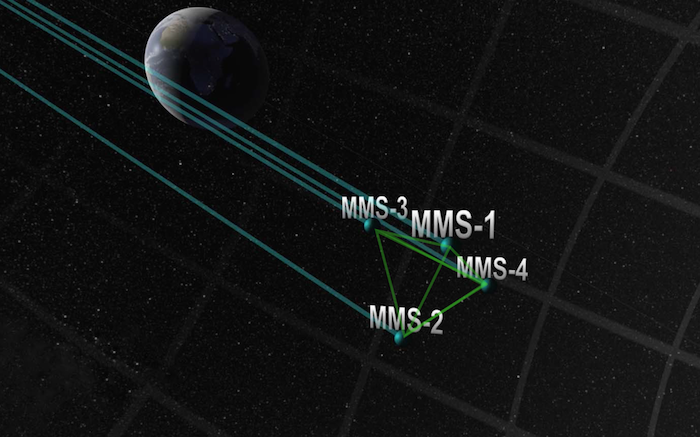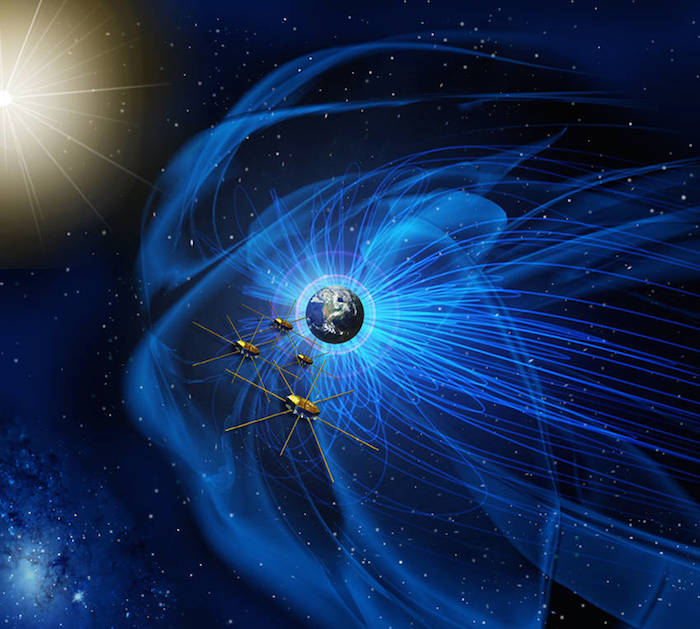.
19.10.2016


On Sept. 15, 2016, NASA’s Magnetospheric Multiscale, or MMS, mission achieved a new record: Its four spacecraft are flying only four-and-a-half miles apart, the closest separation ever of any multi-spacecraft formation. The previous record was first set by MMS in October 2015, when the spacecraft achieved a flying separation of just over six miles apart.
The four MMS spacecraft fly in a pyramid shape, with one satellite marking each corner. This shape, called a tetrahedron, allows MMS to capture three-dimensional observations of magnetic reconnection – critical for fully understanding this process. Magnetic reconnection happens when magnetic fields pinch off and explosively reconfigure, sending particles zooming in all directions. It’s thought to happen throughout the universe, and is one of the few ways that material is energized in space.
MMS’ new, closer formation will allow the spacecraft to measure magnetic reconnection at smaller scales, helping scientists understand this phenomenon on every level.
Quelle: NASA
-
Update: 9.02.2017
.
On Feb. 9, 2017, NASA’s Magnetospheric Multiscale mission, known as MMS, began a three-month long journey into a new orbit. MMS flies in a highly elliptical orbit around Earth and the new orbit will take MMS twice as far out as it has previously flown. In the new orbit, which begins the second phase of its mission, MMS will continue to map out the fundamental characteristics of space around Earth, helping us understand this key region through which our satellites and astronauts travel. MMS will fly directly through regions – where giant explosions called magnetic reconnection occur – never before observed in high resolution.
Launched in March 2015, MMS uses four identical spacecraft to map magnetic reconnection – a process that occurs when magnetic fields collide and re-align explosively into new positions. NASA scientists and engineers fly MMS in an unprecedentedly close formation that allows the mission to travel through regions where the sun's magnetic fields interact with Earth's magnetic fields – but keeping four spacecraft in formation is far from easy.
“This is one of the most complicated missions Goddard has ever done in terms of flight dynamics and maneuvers,” said Mark Woodard, MMS mission director at NASA’s Goddard Flight Space Center in Greenbelt, Maryland. “No one anywhere has done formation flying like this before.”
To form a three-dimensional picture of reconnection, the mission flies four individual satellites in a pyramid formation called a tetrahedron. While a previous joint ESA (European Space Agency)/NASA mission flew in a similar formation, MMS is the first to fly in such an extremely tight formation – only four miles apart on average. Maintaining this close separation allows for high-resolution mapping but adds an extra dimension of challenge to flying MMS, which is already a complex undertaking.
Flying a spacecraft, as one would suspect, is nothing like driving a car. Instead of focusing on just two dimensions – left and right, forward and backwards – you also must consider up and down. Add on to that, keeping the four MMS spacecraft in the specific tetrahedral formation necessary for three-dimensional mapping, and you’ve got quite a challenge. And don’t forget to avoid any space debris and other spacecraft that might cross your path. Oh, and each spacecraft is spinning like a top, adding another layer to the dizzying complexity.
“Typically, it takes about two weeks to go through the whole procedure of designing maneuvers,” said Trevor Williams, MMS flight dynamics lead at NASA Goddard.
Williams leads a team of about a dozen engineers to make sure MMS’s orbit stays on track. During a normal week of operations, the maneuvers, which have been carefully crafted and calculated beforehand, are finalized in a meeting at the start of the week.
To calculate its location, MMS uses GPS, just like a smart phone. The only difference is this GPS receiver is far above Earth, higher than the GPS satellites sending out the signals.
“We’re using GPS to do something it wasn’t designed for, but it works,” Woodard said.
Since GPS was designed with Earth-bound users in mind, signals are broadcast downwards, making it difficult to use from above. Fortunately, signals from GPS satellites are sent widely to blanket the entire planet and consequentially some from the far side of the planet sneak around Earth and continue up into space, where MMS can observe them. Using a special receiver that can pick up weak signals, MMS is able to stay in constant GPS contact. The spacecraft uses the GPS signals to automatically compute their location, which they send down to the flight control headquarters at Goddard. The engineers then use that positioning to design the maneuvers for the spacecraft’s orbits.
While the orbit for each MMS spacecraft is almost identical, small adjustments need to be made to keep the spacecraft in a tight formation. The engineers also rely on reports from NASA’s Conjunction Assessment Risk Analysis, which identifies the locations of space debris and provides notification when objects, like an old communications satellite, might cross MMS’s path. While nothing yet has been at risk for colliding with MMS, the crew has a prepared backup plan – a dodge maneuver – should the need arise.
On scheduled Wednesdays, one or two per month, the commands are sent up to the spacecraft to adjust the tetrahedral formation and make any necessary orbit adjustments. These commands tell MMS to fire its thrusters in short bursts, propelling the spacecraft to its intended location.
Moving MMS is a slow process. Each spacecraft is equipped with thrusters that provide four pounds of thrust, but they also weigh nearly a ton each. The spacecraft all spin like tops, so the timing of each burst needs to be precisely synchronized to push the spacecraft in the right direction.
The next day, once the spacecraft are in their proper locations, a second round of commands are given to fire the thrusters in the opposite direction, to fix the spacecraft in formation. Without this command, the spacecraft would overshoot their intended positions and drift apart with no resisting forces to stop them.
Unlike airplanes, which constantly fire their engines to keep in motion, the spacecraft rely on their momentum to carry them around their orbit. Only short bursts from their thrusters, lasting just a few minutes, are required to maintain their formation and make minor adjustments to the orbit.
“We spend 99.9 percent of the time coasting because we need to be sparing with the fuel,” Williams said.
Launched with 904 pounds of fuel, the spacecraft have only used about 140 pounds in their first two years of operation. However, sending MMS into a wider orbit for its second phase will consume about half the remaining fuel – and there are no gas stations in space for refueling. The operations crew carefully plan each maneuver to minimize fuel consumption. Typical maneuvers take less than half a pound of fuel and the crew hopes their fuel conservation efforts will save MMS enough fuel to allow extended studies past the end of the primary mission.
The new elliptical orbit will take MMS to within 600 miles above the surface of Earth at its closest approach, and out to about 40 percent of the distance to the moon. Previously, the spacecraft went out only one-fifth (20 percent) of the distance to the moon.
In the first phase of the mission, MMS investigated the sun-side of Earth’s magnetosphere, where the sun's magnetic field lines connect to Earth's magnetic field lines, allowing material and energy from the sun to funnel into near-Earth space. In the second phase, MMS will pass through the night side, where reconnection is thought to trigger auroras.
In addition to helping us understand our own space environment, learning about the causes of magnetic reconnection sheds light on how this phenomenon occurs throughout the universe, from auroras on Earth, to flares on the surface of the sun, and even to areas surrounding black holes.
While MMS will not maintain its tetrahedral formation as it moves to its new orbit, it will continue taking data on the environments it flies through. The operations crew expects MMS to reach its new orbit on May 4, 2017, at which point it will be back in formation and ready to collect new 3-D science data, as its elliptical orbit carries it through specific areas thought to be sites for magnetic reconnection.
Quelle: NASA

